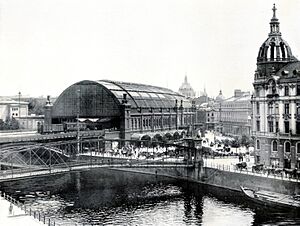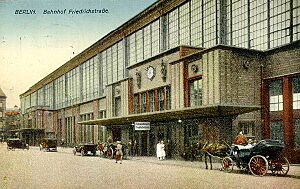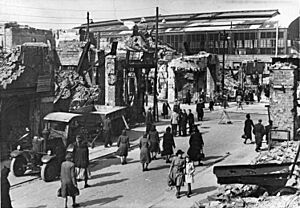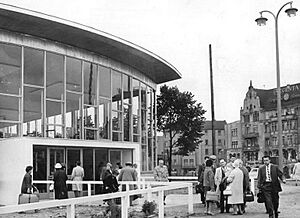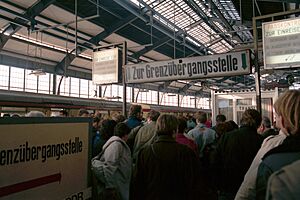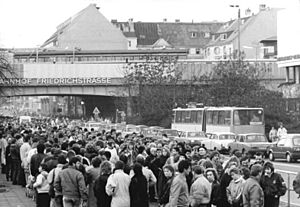Berlin Friedrichstrasse railway station facts for kids
Berlin Friedrichstraße is a very important train station right in the middle of Berlin, Germany. It's a busy place where different types of trains meet, including regional trains that go to nearby cities and S-Bahn trains that travel around Berlin. During the time when Germany was divided into East Germany and West Germany, this station was special. It was one of the few places where people from West Berlin could travel into East Berlin using the underground train lines.
Contents
Welcome to Friedrichstraße Station!
Friedrichstraße Station is more than just a place where trains stop. It's a building with a long and exciting history, especially during the time of the Berlin Wall. Imagine a station that was once a border crossing between two very different parts of a city! Today, it's a modern and busy hub for travelers and commuters.
A Station with a Long History
The first Friedrichstraße station was built a long time ago, opening in 1878. It was designed to be a grand and important building. Over the years, it has been rebuilt and updated many times to handle more and more trains and passengers.
Like many parts of Berlin, the station was badly damaged during World War II. After the war, it had to be repaired and rebuilt.
The Cold War and the "Palace of Tears"
The most famous part of Friedrichstraße Station's history is its role during the Cold War, when Berlin was divided by the Berlin Wall. From 1961 to 1989, the station became a border crossing. This meant it was a place where people could travel between East and West Berlin, but it was very controlled.
East German border guards checked everyone's passports and papers very carefully. It was a serious place, and many people felt nervous passing through.
Crossing the Border
If you were traveling from West Berlin into East Berlin, you would go through special checkpoints. There was even a building called the Tränenpalast, which means "Palace of Tears." This building was where people said goodbye to their friends and family who were staying in East Berlin. Many tears were shed there because it was hard to know when they would see each other again.
The Fall of the Wall
On November 9, 1989, the Berlin Wall fell. This was a huge moment in history! Suddenly, the strict border controls at Friedrichstraße Station were gone. Thousands of East Berliners rushed to the station to cross into West Berlin, many for the first time. It was a time of great joy and excitement.
The "Palace of Tears" changed from a place of sad goodbyes to a place of happy reunions.
Today's Busy Hub
Today, Friedrichstraße Station is one of Berlin's busiest train stations. It connects different parts of the city and region. You can catch S-Bahn trains, U-Bahn (underground) trains, and regional trains here. The station has been beautifully renovated, bringing back some of its old charm.
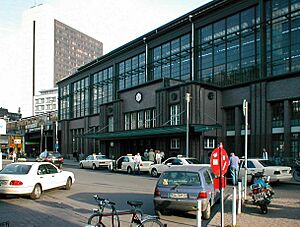
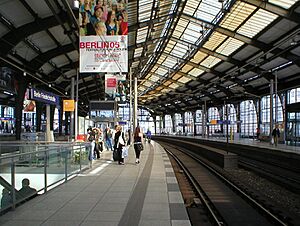
It's a great example of how a historic building can be updated for modern use while still remembering its important past.
Images for kids


